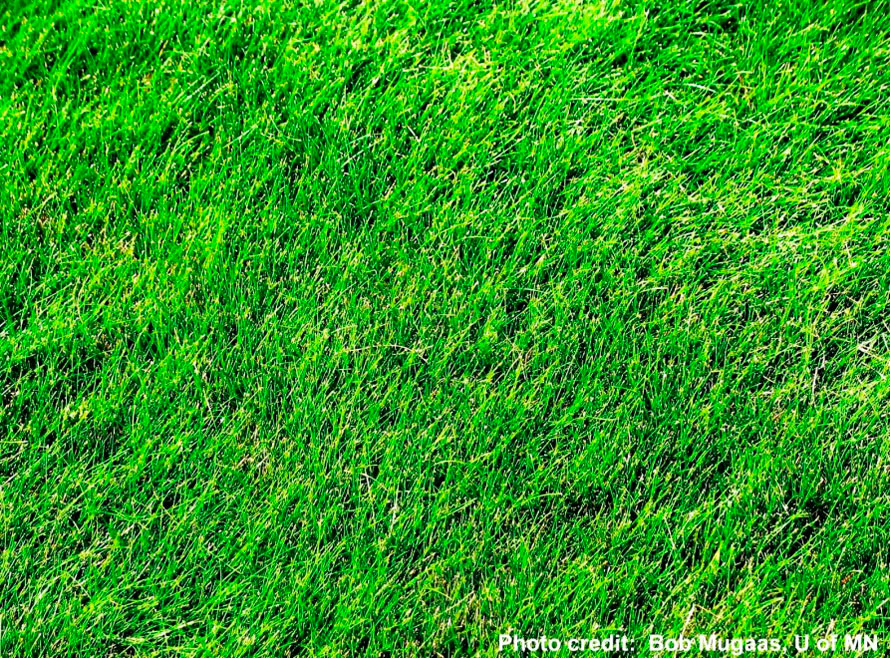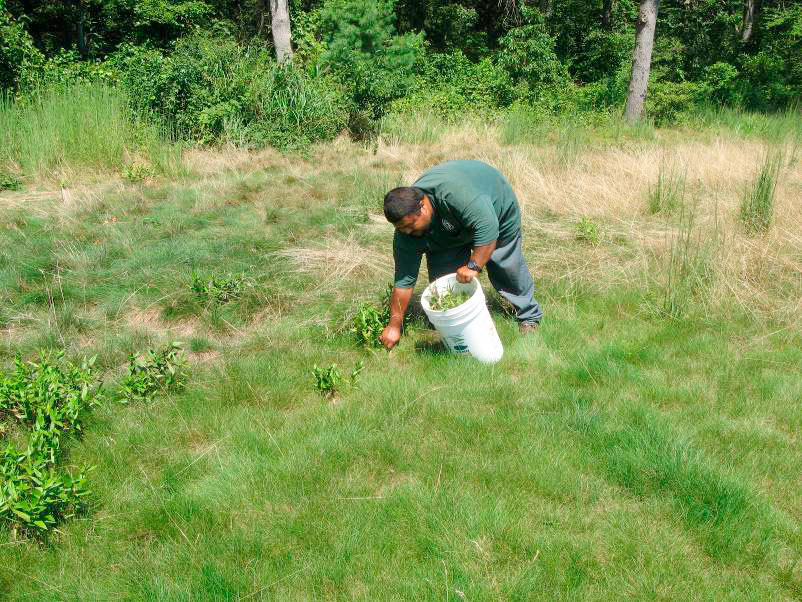An IPM manager uses a mix of preventive and reactive strategies to manage pest problems. Course management decisions and cultural practices are ongoing, while reactive measures are decided and implemented in season. Selecting from a number of management options according to incoming information instead of the calendar is a hallmark of an IPM manager.
Diversification
Diversification of management options is key, using a variety of cultural, biological, physical, and possibly chemical strategies. The case against sole reliance on chemical approaches is obvious because it promotes resistance, and frequent use may subject applicators, golfers and the environment to unnecessary risks. Similarly, reliance on any other single-tactic approaches is also not recommended, because if it fails, damage or turf loss is likely which can also negatively affect water quality. IPM’s diversification of tactics allows for multiple layers of protection, and therefore better insurance against pests.
Role of Cultural Management
Turfgrass is a perennial plant system in which cultural practices, especially irrigation, mowing, topdressing, aeration, and venting, greatly affect both short and long term plant health. Healthy plants and soil can better withstand pest pressure. Weak turf can be outcompeted by weeds that take advantage of bare ground or thin turf. Pathogens in particular can take advantage of weak, stressed, or otherwise unhealthy plants and cause disease. Unhealthy plants are also less able to fend off, compensate for, mask, or recover from insect damage. Below are examples of how an IPM approach can be used to for a specific weed, disease, and insect pest issue.
Weed Example
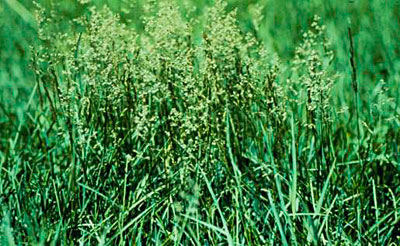 Poa annua. Source: Jennifer Grant.
Poa annua. Source: Jennifer Grant.One of the most effective prevention strategies in weed management is to use the appropriate turf varieties for the specific site conditions and intended use on the golf course. For example, a recent development in some golf courses is the use of tall fescue/blue blends in the rough because heat and drought in the summers create challenges for turf management. Read more
Disease Example
Dollar spot, caused by the pathogen Sclerotinia homoeocarpa, is a common golf course disease in New York State. Besides using chemical controls, managers can plan to lessen disease incidence and severity with the following activities:
- Plant resistant cultivars of creeping bentgrass such as Memorial and Declaration.
- Minimize moisture stress and leaf wetness.
- Remove morning dew as early as possible.
- Roll putting greens three or more times per week.
- Apply biological organisms known to suppress dollar spot such as Bacillus licheniformis, Bacillus subtilis, and Pseudomonas aureofaciens.
- Use horticultural oils (Civitas), labeled for the intended use both for treated area and pest, instead of or in conjunction with traditional fungicides.
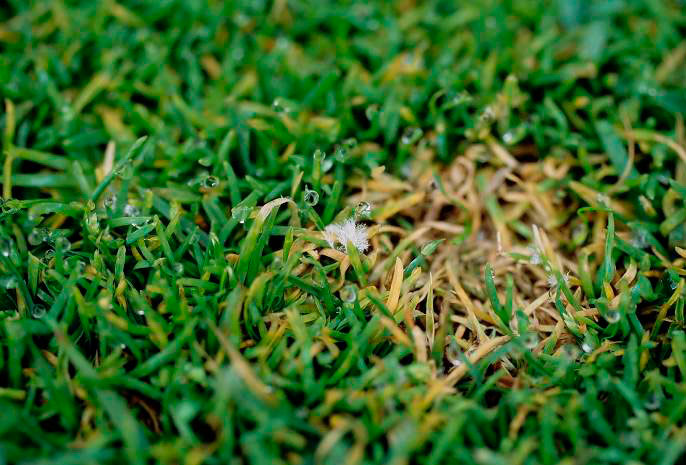
Dollar spot. Source: Jennifer Grant.
Insect Example
Annual bluegrass weevils (ABW) are pests of golf courses in many parts of New York. The only cultural practice known to successfully minimize their damage is to reduce the amount of annual bluegrass in infested areas. In mixed stands of annual bluegrass and creeping bentgrass, as is commonly found on putting greens, practices that favor bentgrass can be promoted. In other areas, it may be acceptable to convert the grass to alternate species such as ryegrass or Kentucky bluegrass. It may also be possible to protect areas by creating a barrier strip of an alternate grass species that deters the spring migration of ABW adults traveling from their overwintering sites to playing surfaces.
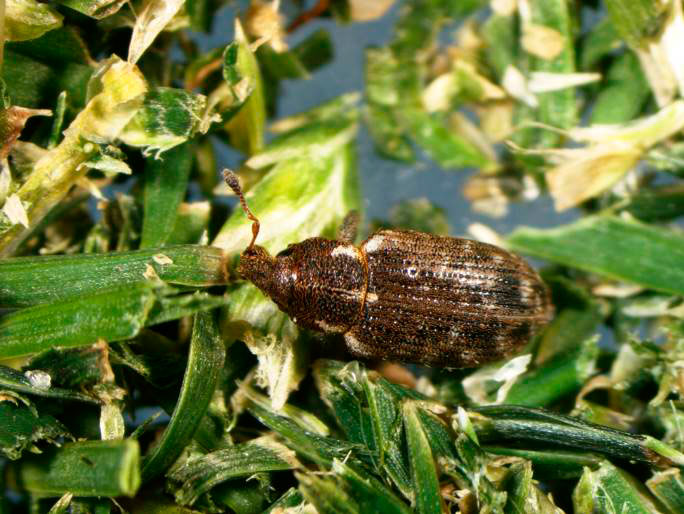
Annual bluegrass weevils. Source: Jennifer Grant.
Vacuuming has been used to monitor ABW adults in turf, but may also work as a physical and mechanical control practice if done frequently, especially during the spring migration. Biological control methods have been largely unsuccessful in scientific research, but the use of entomopathogenic nematodes may still hold promise.
Beyond the techniques listed, IPM for ABW has relied mainly on careful monitoring of the insect as well as phenological indicators and degree days to target insecticide applications. Pitfall traps, soap flushes, and vacuum sampling detect when and where the adults are moving from their overwintering spots. An insecticide targeting adults is typically timed for the peak migration time. Subsequently, these sampling techniques, along with saline floats that monitor larval development, are used to time the application of an insecticide targeted at 3rd to 5th instar larvae.
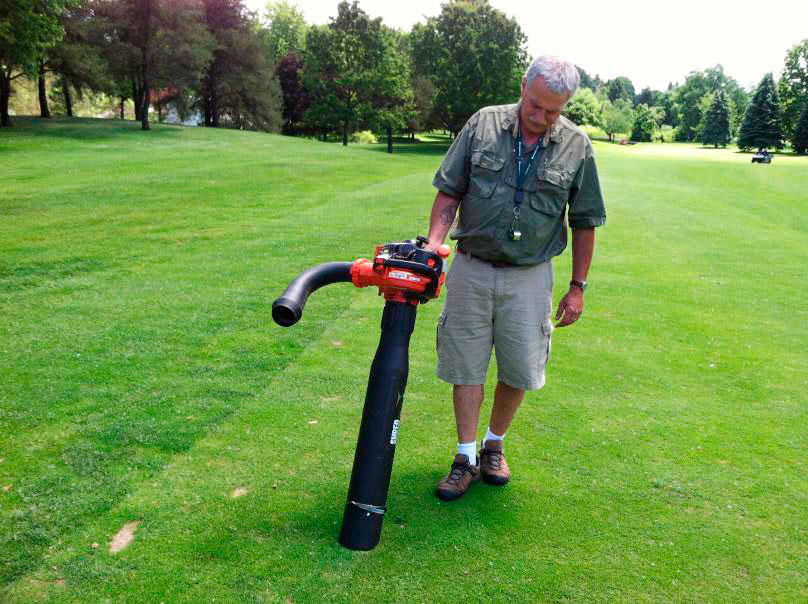
Vacuuming to determine annual bluegrass weevil adult presence, location, and movement. Source: Jennifer Grant.
Use of Softer and Alternative Pesticides
IPM encourages the use of pesticides as a “last resort” when other methods of pest control prove to be inadequate. However, when pesticides are deemed necessary, an effective product least likely to harm human health or the environment should be selected. Other management options include using an alternative product, such as biological controls or reduced risk pesticides.
Biological Controls
Biological control uses other living organisms to suppress or eliminate pests. Several organisms are known to have some efficacy against turfgrass pests and have been marketed as pest control products. These biological controls may act to suppress pest populations alone or work synergistically with other natural, cultural, physical, or chemical management methods. Examples of biological controls that are commercially available in New York State are provided in the table below.
Biological controls
| Beneficial Bacteria | Action |
|---|---|
| Bacillus licheniformis | Labeled for dollar spot management |
| Bacillus subtilis | Labeled for management of brown patch, dollar spot, powdery mildew, rust and anthracnose |
| Pseudomonas aureofaciens (strain TX-1) | Labeled for management of anthracnose, dollar spot, pink snow mold and pythium |
| Bacillus thuringiensis | Labeled for management of caterpillars in turf. A strain that affects white grubs is known, but not currently commercially available. |
| Paenibacillus popilliae and Paenibacillus lentimorbus | Cause “milky spore disease” and are labeled for management of Japanese beetle grubs in turf. Other strains cause milky spores in other species of grubs, but are not commercially available. |
| Entomopathogenic Nematodes | Action |
| Heterorhabditis bacteriophora and Steinernema glaseri | Effective against white grubs |
| Steinernema carpocapsae | Effective against cutworms and possibly annual bluegrass weevils |
Reduced Risk Pesticides
The EPA defines conventional “Reduced Risk” pesticides as having one or more of the following advantages over existing products:
- low impact on human health
- low toxicity to non-target organisms (birds, fish, and plants)
- low potential for groundwater contamination
- lower use rates
- compatibility with IPM
A number of reduced risk pesticides can be used on turfgrass in NYS. Biological pesticides, which also have many of these desirable characteristics, are classified separately by the EPA.
Reduced risk pesticides
| Category | Reduced Risk Pesticide |
|---|---|
| Azoxystrobin | |
| Boscalid | |
| Fludioxonil | |
| Trifloxystrobin | |
| Bispyribac-sodium | |
| Carfentrazone-ethyl | |
| Mesotrione | |
| Penoxsulam | |
| Chlorantraniliprole | |
| Spinosad |
